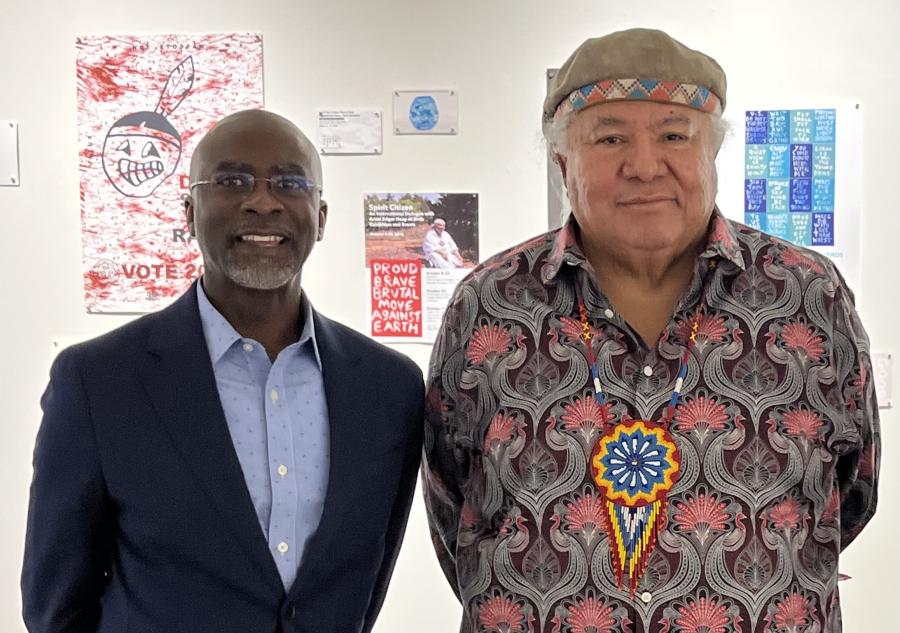
By Wakinyan LaPointe
Today, hair is one of our greatest sources of healing, but also, one of our greatest struggles. Remembering a time when the United States forced Indigenous Peoples and youth to cut their hair during the boarding school era, and the legacy of resiliency and healing we now find ourselves in.
However, we are still faced with lingering challenges when it comes to customary hair traditions. Too often, Indigenous communities who encourage the revitalization of traditional hair customs encounter lateral oppression while the norm of short hair is seen as the standard to strive for under western exceptionalism. This is compounded by the immense discrimination youth may face for practicing traditional hair customs in the western world. Sometimes, people write traditional hair customs off as a generic expression of pan-Indianism, leaving out the rich and dynamic customary hair traditions of distinct, diverse Indigenous Peoples.
Bringing back customary hair traditions stands against archaic ethnocidal policies of long ago in the spirit of self-determination. By helping to overturn the boarding school mentality and policy of: “kill the Indian, save the man,” with the exercise of this inherent, customary right of pehin (hair). Overtime, I have learned from Lakota elders about pehin, gathering stories on the specific customary traditions of the Lakota Oyate. Below are some general examples of Lakota customary hair traditions.
Pehin is spirit, prayer, power, healing, and medicine. For example, among the Lakota, it spans ceremonies and revered customary traditions of wasigla (mourning); offers woawayanka (protection) and wowash’ake (power) in battle, life, and death; strengthens wonagiksapa (spiritual balance and wisdom), governance, and decision-making; extends kinship and the making of relatives from the spirit world to here, strengthening tiospaye (extended family, an original Lakota organization of the land); hair guides and empowers one’s capacity for leadership; it is pejuta (medicine) in healing and health, among other customary traditions. Whether a lock, strand, or still on the head, it has physical, literal, and real meaningful usages in the Lakota way across diverse purposes of life. It relates to creation stories. The ways in which hair was worn, what was worn in the hair, how it was cut (ceremonially), meant and signified many things to the people.
Pehin is sacred and powerful. Among the Lakota, there were deep, resounding, and revered purposes for hair that bridged life and death. Pehin is quite literally an extension of the spirit and ancestral connection. As the hair grows so does the spiritual connection. Because in the process of caring for their own hair and carrying out its customary traditions, one learns to braid together wisdom, guidance, and knowledge, deepening their understanding in life. This often came with greater responsibility.
Pehin is quite literally our power to health, healing, protection, and defense of peace. Hair teaches us that death is a relative, helping our loved ones on their journey by the imparting (cutting) or caretaking of pehin, giving them the power to make the journey with otakuye (relatives). It also gave people the power to overcome in life and to be successful in their ihamble: dreams. Pehin yuksa (cutting) also helped in the renewal or beginning of a new path and journey in life, signified a new stage of growth, or strengthened one’s abilities to fulfill a vow.
Pehin is a way for our ancestors to continue investing in us, to guide, and help us; the connection is reciprocal.
While it is expressed as a pan-Indian practice across decolonization or indigenization rhetoric, in Lakota, there are many more ways of life and purposes for pehin that span generations, across tiwahe (family, an original organization of the Lakota Oyate dedicated to helping the people) and tiospaye. But whether long or short, pehin holds deep resounding spiritual importance. The tancan (body), cante (heart), nagi (spirit), tawacin (mind), held just as much meaning, customs, and purpose.
For the Ina (mother) or ate (father), braiding your child’s hair, pouring water on it, preparing it in wocekiya (prayer, good energy), strengthens the mind, body, and spirit. Memories of how my Ina prepared my hair each day helped me through many of the modern challenges I described above growing up.
Azilya: smudge pehin for health, guidance, and good thoughts.
Deepening understandings and teachings about pehin can help create a greater community of support, guidance, and empowerment for youth who are practicing customary hair traditions. Honoring the spiritual legacy, resiliency, and healing power of our ancestors through customary hair traditions.
These are some general understandings of pehin, they are not specific or in-depth practices, and provide meaningful insights from a Lakota worldview.
--Wakinyan LaPointe (Sicangu Lakota Oyate) lives in Minnesota, United States. He is an advocate for Indigenous rights, and is passionate about his Lakota language and culture. Working alongside his tiwahe (family) and the global Indigenous movement, Wakinyan attends the UN Permanent Forum on Indigenous Issues each year. He is a convener of the Mni Ki Wakan: World Indigenous Peoples Decade of Water Summit. Wakinyan started an organization centered on Indigenous innovation with his brother.



